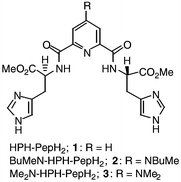Synthesis, characterization, and spectroscopic properties of three novel pentadentate copper(II) complexes related to the metal-chelating inhibitors against DNA binding with HIV-EP1
Abstract
Three potentially five-coordinate

a
Department of Physical Chemistry, Faculty of Pharmaceutical Sciences, Kumamoto University, 5-1 Oe-honmachi, Kumamoto, Japan
E-mail:
gotomphi@gpo.kumamoto-u.ac.jp
Fax: +81-96-371-4314
b Department of Chemistry, University of Delhi, India
c Department of Bioorganic Medicinal Chemistry, Faculty of Pharmaceutical Sciences, Kumamoto University, 5-1 Oe-honmachi, Kumamoto, Japan
d Institute for Chemical Research, Kyoto University, Uji, Kyoto, Japan
e Osaka University of Pharmaceutical Sciences, Nasahara, Osaka, Takatsuki, Japan
Three potentially five-coordinate

 Please wait while we load your content...
Something went wrong. Try again?
Please wait while we load your content...
Something went wrong. Try again?
H. Kurosaki, R. K. Sharma, S. Aoki, T. Inoue, Y. Okamoto, Y. Sugiura, M. Doi, T. Ishida, M. Otsuka and M. Goto, J. Chem. Soc., Dalton Trans., 2001, 441 DOI: 10.1039/B006949N
To request permission to reproduce material from this article, please go to the Copyright Clearance Center request page.
If you are an author contributing to an RSC publication, you do not need to request permission provided correct acknowledgement is given.
If you are the author of this article, you do not need to request permission to reproduce figures and diagrams provided correct acknowledgement is given. If you want to reproduce the whole article in a third-party publication (excluding your thesis/dissertation for which permission is not required) please go to the Copyright Clearance Center request page.
Read more about how to correctly acknowledge RSC content.
 Fetching data from CrossRef.
Fetching data from CrossRef.
This may take some time to load.
Loading related content
